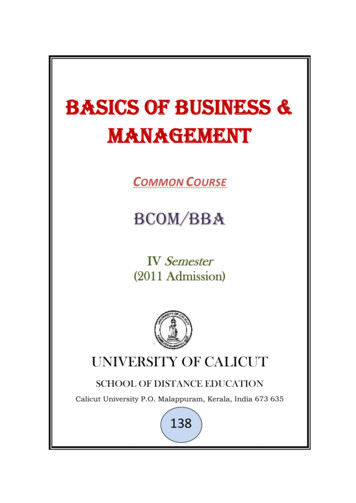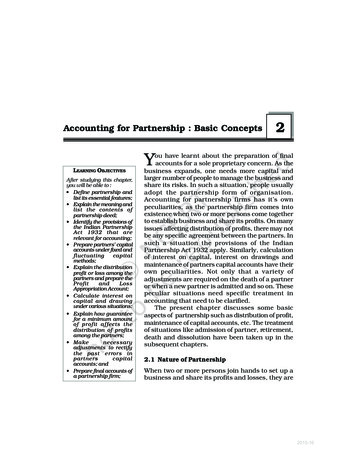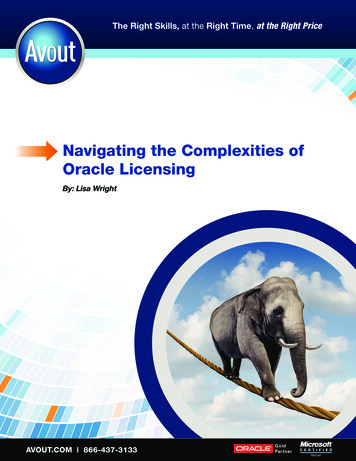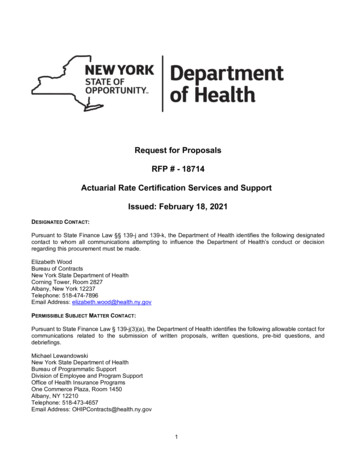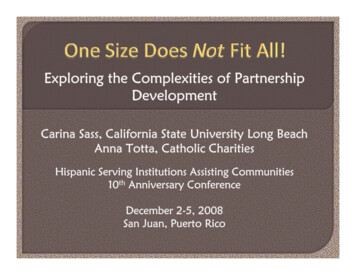
Transcription
Exploring the Complexities of PartnershipDevelopmentCarina Sass, California State University Long BeachAnna Totta, Catholic CharitiesHispanic Serving Institutions Assisting Communities10th Anniversary ConferenceDecember 2-5, 2008San Juan, Puerto Rico
Carina Sass, Associate Director, CSULB Center forCommunity Engagement Project Director, Carmelitos Initiative (COPC 2003) Project Director & PI, Villages at Cabrillo (HSIAC 2007) 17 years experience in campus/community partnerships Anna Totta, Regional Director, Catholic CharitiesSan Pedro/South Bay Region Participated in the partnership for Carmelitos Initiative asExecutive Director for Long Beach BLAST. Partner and Sub-grantee with Villages at Cabrillo HSIAC grant. More than 17 years experience with cross-organizationalcollaborations and 36 years experience with non-profits.2
Explore the complexities of particularpartnerships.Understand how and why successful strategiesin one partnership may not be successful inanother.Identify the ways that organization's cultures,politics, and expectations can impactpartnership developmentFind strategies to respond to the resultingchallenges or opportunities that may arise.3
I.II.III.Present two partnerships: one COPC-supportedand one HSIAC-supported.Identify then discuss strengths, challenges, andcritical moments or turning points ofcampus/community partnership.Explore implications for partnershipdevelopment.4
Carmelitos Initiative & Villages at CabrilloLong Beach, California5
Population: 487,100* 5th largest city in California,located in denselyurban South Bay region of Los Angeles County Considered most ethnically diverse major city inthe U.S. with 40 languages spoken One of largest Cambodian communities in U.S.*2004 Census Data6
23%of Long Beach’s population is living inpoverty 48% of L.B. households earned less than 35,000 per year.7
January2007 LB Homeless Census: 3,829(3,145 adults, 684 children). Homeless’ Monthly Income* 619 or less (80%) 224 or less (40% ) no monthly income (17%)*2004 Homeless Assessment8
Large, urban, comprehensive 4-yearuniversity in the 23-campus California StateUniversity system.9
Facilitates connections between theuniversity and the community throughservice-learning, community-based research,and engagement initiatives to enrichcampus-community experiences andstrengthen community capacity.10
Greater Long Beach/South Bay CommunityPartnership(Carmelitos Initiative)Villages at CabrilloLong Beach, California11
Greater Long Beach/South Bay CommunityPartnership(Carmelitos Initiative)Villages at CabrilloLong Beach, California12
Community-Campus Partnerships & Initiatives: GreaterLong Beach/South Bay CommunityPartnership: Carmelitos Initiative (COPC ):Multi-campus, multi-agency partnership toaddress needs of residents of a 713 unit,county-run public housing community.13
1. Los Angeles County Community DevelopmentCommission/Housing Authority (LACDC)2. Carmelitos Housing Development—LACDCpublic housing community3. California State University Long Beach4. Long Beach City College5. California State University Dominguez Hills6. Long Beach BLAST—after school programs7. Goodwill of Long Beach & South Bay—workforce development14
15
What Worked? Clear shared vision from the start Goals were in line with partners’ priorities Partnership developed for 14 months prior tosubmitting COPC proposal Met on a regular basis (monthly, sometimesmore frequently) Communicate via e-mail and phone regularly Partners demonstrate commitment at both theindividual and organizational levels (to varyingdegrees)16
What Worked? Manageable number of partners Relatively equal participation among partners Became advocates for one another Dealing with problems as they arise Build in social interaction (relationship building) Continually building trust Learning to work as a group Learning to share & pool resources Learning how to disagree and make up17
Partnership Challenges? Changes within partnering organizations: Personnel changes Administrative turnover Funding/program cuts Partner organizational politics Incompatible policies/procedures among partners Varying levels of commitment and/or trustwithin partnering organizations (leadershipversus staff representative)18
Critical Turning Points Community Café: defined need, establishedpartnership Post-COPC proposal barbeque: social/bondingsolidified partnership and established “traditions” LACDC Educational Partnership Symposium:Partners were central in organizing this countywide event. LACDC Executive Director CarlosJackson began calling for a formal assessment ofthe benefits of partnerships with local collegesand universities.19
Critical Turning Points Long Beach City College City SERVE Program iseliminated: LBCC representative continueswithout organizational support Key founding partner leaves LACDC: Partnershipis significantly affected by the loss of oneindividual. LACDC Office of Educational Partnershipsestablished: Step toward institutionalizationwithin the LACDC, but creates challenges withpartnership20
Greater Long Beach/South Bay CommunityPartnership(Carmelitos Initiative)Villages at CabrilloLong Beach, California21
Community-Campus Partnerships & Initiatives: Villagesat Cabrillo (HSIAC): Multi-agencypartnership identifies and addresses servicegaps at the Villages at Cabrillo.22
26-acre former U.S. Naval housing siteComprehensive residential social service complexserving both veteran and non-veteran homelessindividuals in need of transitional and supportivehousing services.From the old (Navyhousing)To the new!23
The HSIAC-funded partnership supports theindependent programs for homeless familiesand youth by helping to Establish a structure to enhance cooperation andcollaboration Facilitate shared resources to meet common goals Promote greater sense of community within theVilllages at Cabrillo24
Family Housing & Support Services:1. Catholic Charities—Emergency Shelter2. GLASS—Teen Shelter & Group Home3. New Image—Transitional Shelter4. PATH Ventures—Permanent Housing & SupportServices5. The Salvation Army—Transitional Shelter6. 1736 Family Crisis Center—Support Services7. Comprehensive Child Development—Childcare &Preschool25
Educational Support:8. California State University Long Beach9. Long Beach Unified School District:x Hudson School (K-8 grades)x Bethune Transitional Program for Homeless Children26
Educational Support:10.Long Beach Parks & Recreation WRAP—AfterSchool Program11. Century LIFT—After School Academic Tutoring12.Long Beach BLAST—Academic Mentoring13.School on Wheels—Academic Tutoring27
14. Cantwell-Anderson, Inc.15. Century Housing, Inc./Century Villages atCabrillo16. U.S. Veteran’s Initiative28
HSIAC funding supported the creation of theOasis Center along with additional leveragedresources through partners such as CatholicCharities.29
Life Skills classes, job search assistance, afterschool tutoring and enrichment programs,and computer help are offered.30
CSULB Oasis Community CenterOasis Community Center31
PATH Ventures will offer supportive services inJanuary 2009 for the Family Commons at Cabrillo,81-units of permanent subsidized housing.Construction is almost complete and move-in isanticipated for the end of December 2008.32
What is Working? Key partners with a shared vision Prior university involvement Needs/issues emerged from community partners Established monthly meetings already in place(Directors Meeting)33
What is Working? University participated in Directors Meetings for7 months prior to submitting HSIAC proposal Active involvement and commitment from keypartners34
Partnership Challenges? Partnership development with sixteen partners Negotiating differences of philosophy, values,culture among organizations Understanding hierarchy, decision-makingdifferences. Balancing autonomy vs. collaboration35
Partnership Challenges? Territory issues among partnersPartners’ widely varying degrees of investmentStaff changesNeed was recognized by most but not allGoals of partnership not central to individualagencies’ mission.36
Partnership Challenges? For some partners, Villages at Cabrilloprograms are a small percentage of totalprograms. Understanding/negotiating differentmanagement styles37
Critical Turning Points Youth Concerns Committee established:facilitated sense of shared goals Success in connecting several CSULB faculty andstudents to meet community-identified needs:begin to establish credibility Opening of Oasis Community Center: positiveresponse of residents, increased interest amongstaff of previously less-involved shelters.38
CCPH* “Principles of Good Community-CampusPartnerships” Agreed-upon mission, values, goals, & outcomes Mutual trust, respect, genuineness, andcommitment Builds upon identified strengths and assets;addresses areas for improvement Balances power, shares resources*CCPH – Community‐Campus Partnerships for Health(see http://futurehealth.ucsf.edu/ccph.html)39
CCPH* “Principles of Good Community-CampusPartnerships” Clear, open, accessible communication Agreed-upon roles, norms, and processes Feedback among all stakeholders to continuallyimprove partnership and its outcomes Partners share credit for its accomplishments Partnership develops and evolves over time*CCPH – Community‐Campus Partnerships for Health(see http://futurehealth.ucsf.edu/ccph.html)40
Focus on the partnership relationship and process andidentify:1.What works? (successes/strengths of partnership)2.What are challenges to your partnership’s success?3.What are significant “critical moments” or turningpoints that impact the partnership? (positive ornegative)41
Identify examples of “what works” (partnershipstrengths) and what is a challenge?Identify examples of critical moments withinpartnerships What characteristics of your partners and partnershipinfluence what works and what becomes a challenge tothe partnership? How might an outcome differ within anotherpartnership?42
How can we determine what is within the scope of thepartnership’s control and what is not? How do we respond to influences that are beyond ourcontrol to change? How can we anticipate and respond appropriately tofactors that are unique to a particular partnership? Can we “learn lessons” from one partnership to positivelyimpact another? How?43
Community/University partnerships require concurrentattention to both the purpose and activities of thepartnership and the partnership itself. Seek to understand your partners and avoid maintainingan “organization-centric” perspective (seeing everythingfrom the perspective of your organization). Expect the best of your partnership but recognize thatreal life is complex challenges need not become failures!44
Carina Sass, California State University Long Beachcsass@csulb.edu562-985-2376Anna Totta, Catholic Charities, San Pedro Regionatotta@ccharities.org562-591-164145
Carina Sass, Associate Director, CSULB Center for Community Engagement Project Director, CarmelitosInitiative(COPC 2003) Project Director & PI, Villages at Cabrillo (HSIAC 2007) 17 years experience in campus/community partnerships Anna Totta, Regional Director, Catholic Charities San Pedro/South Bay Region Participated in the partnership for CarmelitosInitiative as




